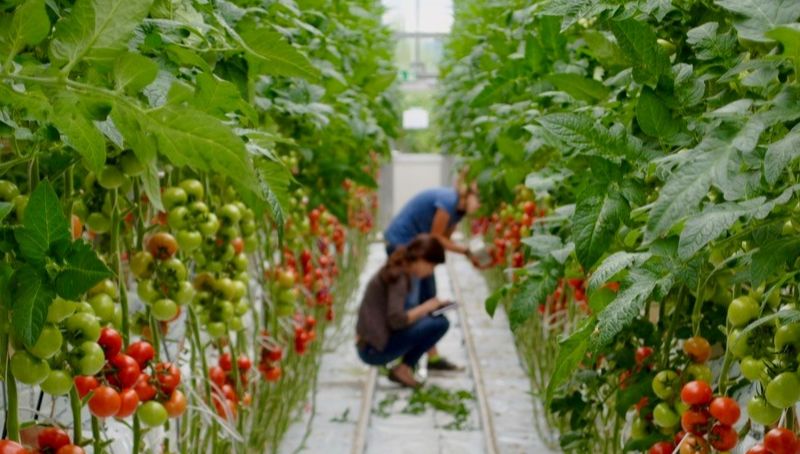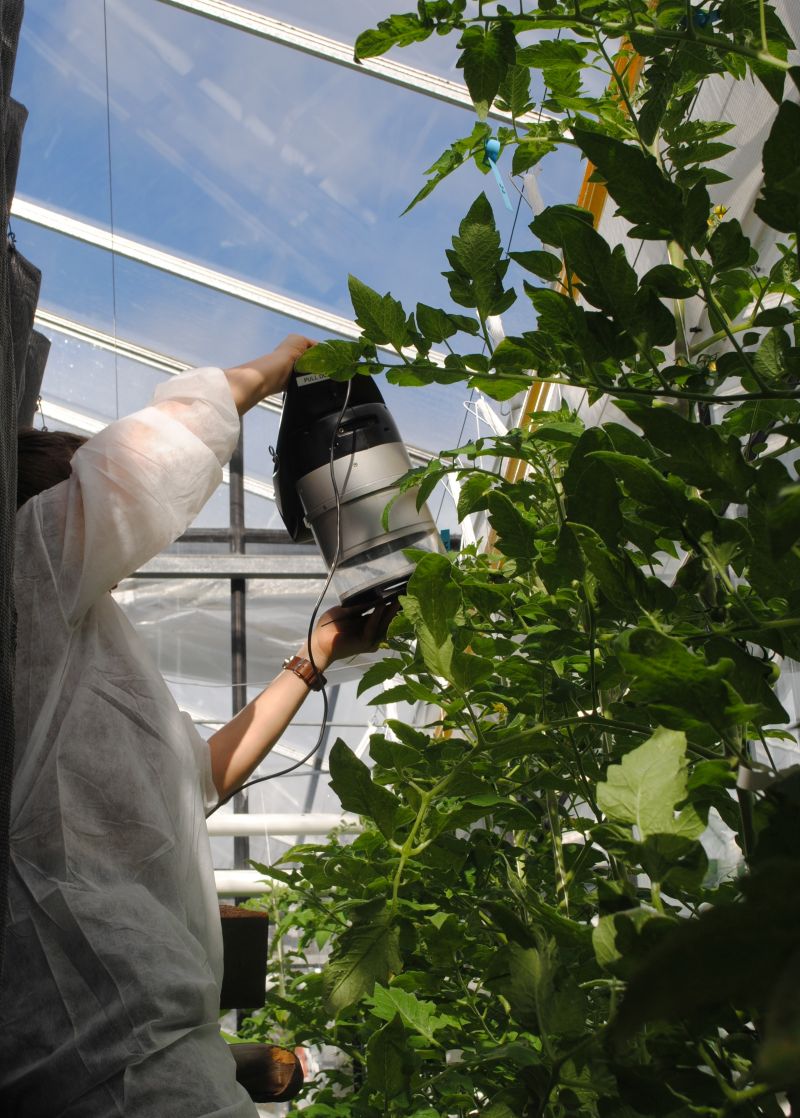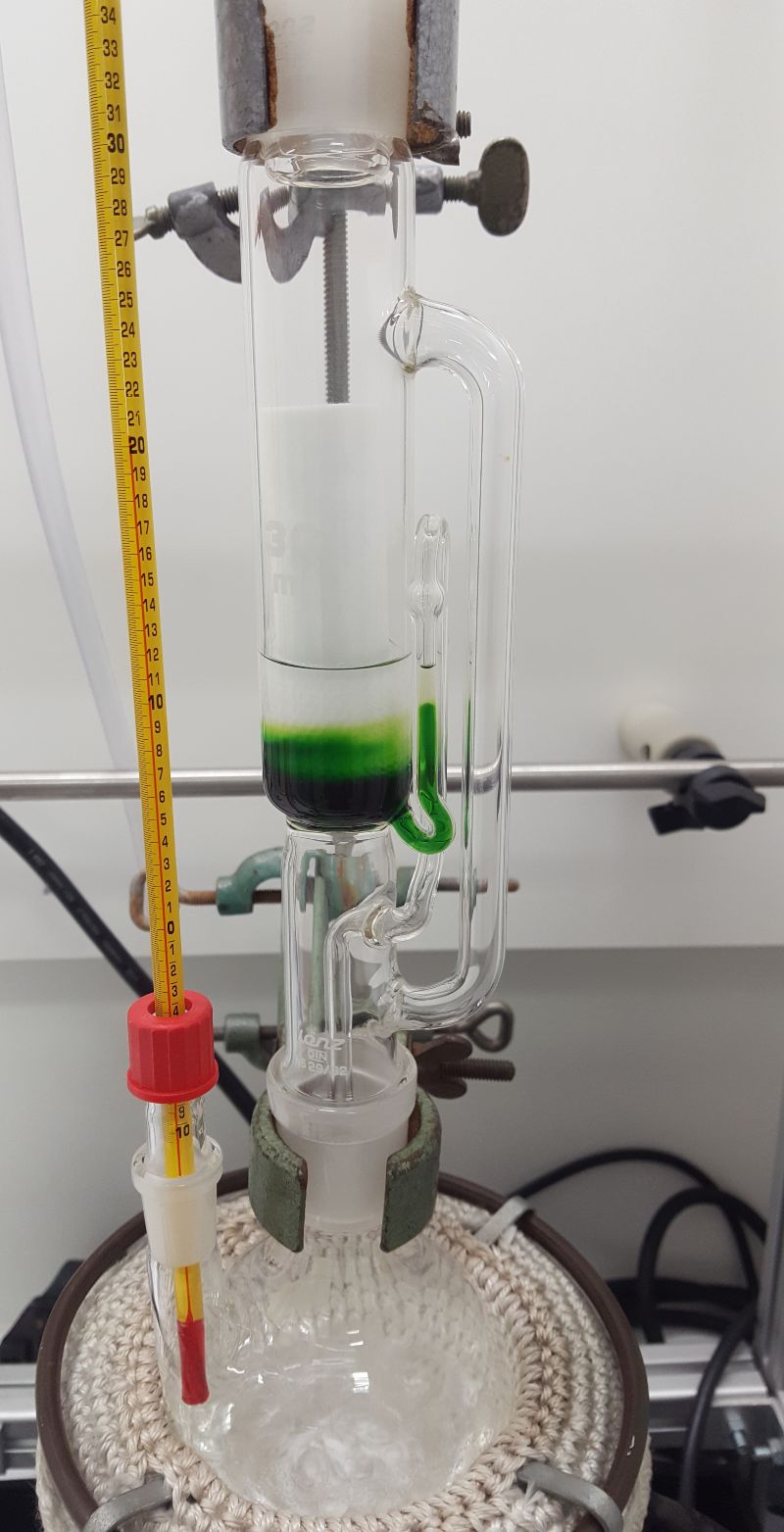
Tomatoes are cultivated in greenhouses over a period of many months. The remaining tomato plants are composted at the end of the production phase in autumn. Is there any way to make better use of these leftovers? One idea for adding value to them was established in the project InducTomE. Tomato leaves contain, among other substances, rutin and solanesol, which are already marketed as food supplements or drugs. In order to significantly increase the concentration of these phytochemicals, the tomato plants were deliberately subjected to environmental stresses.
Tomatoes are one of the most widely cultivated fruits in the world. In Germany, tomatoes are mostly grown in greenhouses. There, the plants produce their fruits over months. At the end of tomato production in autumn, the plants are impressively tall. The large plants remain as residual biomass and leaves are also repeatedly removed from the plants between the individual fruit harvests. These leaves and residual plants contain bioactive ingredients that can be of industrial value. For example, they have antioxidant, antimicrobial or also virucidal effects. Such so-called phytochemicals often also have pharmacological effects and can be used as dietary supplements. Thus, the flavonoid rutin contained in tomato leaves shows antioxidant and anti-inflammatory effects and rutin derivates are used in vein therapy. The isoprenoid solanesol is the precursor for coenzyme Q10 und vitamin K, which are used in the cosmetic industry and as food supplements.

Multiple benefits
Plants produce such bioactive substances to protect themselves against environmental influences and to interact with the environment. In doing so, some phytochemicals are produced in greater quantities during environmental stress and protect plants against damage. The scientists working on the InducTomE project wanted to make use of this fact: following the last fruit harvest, the tomato plants were exposed to targeted environmental stresses such as heat, cold or nutrient deficiency to accumulate the desired ingredients rutin and solanesol. This would add value to plant residues that otherwise would usually be used only as compost at the end of the tomato production. The dual use of the plants for tomato production and for the extraction of valuable ingredients means an expansion of the value chain. In addition, the biomass can be used to produce energy and so-called bulk chemicals such as sugar or bioethanol. This is already planned in the project. Such value chains are resource-friendly since the cultivation of the corresponding energy or medical plants is saved.
Plant scientists from Forschungszentrum Jülich and RWTH Aachen, together with horticultural scientists of the University of Bonn, tested the environmental conditions that cause the enrichment of rutin and solanesol. Many different stress conditions were initially tested on young plants and the most suitable were transferred to production greenhouses. The combination of nutrient deficiency, cold and increased light intensity resulted in a maximum increase in rutin content. Heat increased the solanesol content. In addition, the option to change the cultivation conditions already during fruit production and the effect on the ingredient content of the leaves as well as on fruit quality and yield was investigated. In order to also identify further usable phytochemicals, gene expression studies and untargeted metabolite analyses were carried out. These new identified ingredients could then also be produced and marketed by extraction or by biotechnological production after elucidation of their biosynthesis pathways.

Proof at the plant
To verify the successful application of stress conditions, optical methods were developed for detecting the increase in the quantity of rutin and solanesol. Different optical methods were tested, which can also be carried out by horticultural producers in greenhouses. Fluorescence measurements as well as simple quantification of the leaf color could be established to check the success of the applied stress conditions. The Chamber of Agriculture North Rhine-Westphalia at the Experimental Center Horticulture in Straelen supported the project by actively providing experimental setups and advising the project partners. The task of the process engineer at RWTH Aachen was to develop processes for the extraction and purification of phytochemicals from tomato leaves and subsequent biorefining of the plant residues. Concepts for an efficient, environmentally friendly process were developed that met the requirements of the potential market sectors for rutin and solanesol. An economic assessment of the process showed that the total costs could be significantly reduced by sequential extraction of the ingredients. In addition, the further usage of the tomato biomass in biorefinery processes turned out to be a suitable and efficient process.
Increasing profitability
Agricultural economists at the University of Bonn investigated possible ways to introduce the dual usage of tomato plants into the market. Two sectors were initially identified in which rutin and solanesol could be marketed and the corresponding regulations were checked. The participants involved in the production chains were then identified and their willingness to innovate was investigated. In addition, various market entry barriers that may be an obstacle for the new value chain were assessed. The results show that the economic efficiency can be significantly increased: first, by extracting and marketing several bioactive substances and, second, by reducing production costs, for example by using central extraction plants.
Meanwhile, the InducTomE consortium has transferred the idea to produce phytochemicals from leaves and residual plants to bell pepper production. The BMBF project TaReCa ran from 2017 to 2020 in collaboration with an advisory board from the aroma and fragrance industry, the biocide industry and horticulture, which brought in the interests and possibilities of potential industry partners.
Project Coordinator
Prof. Dr. Björn Usadel1, Dr. Alexandra Wormit
ABBt – Botany and Molecular Genetics, RWTH Aachen
Participating Core Groups
Prof. Dr. Björn Usadel1, Dr. Alexandra Wormit, Dr. Julia J. Reimer
ABBt – Botany and Molecular Genetics, RWTH Aachen
Prof. Dr. Ulrich Schurr, Dr. Anika Wiese-Klinkenberg1, Dr. Björn Thiele, Dr. Laura Junker-Frohn
IBG-2 Plant Sciences, Forschungszentrum Jülich
Prof. Dr. Georg Noga, PD Dr. Mauricio Hunsche, Dr. Simone Röhlen-Schmittgen, Dr. Tanja Groher
INRES – Horticultural Sciences, University of Bonn
Prof. Dr. Andreas Jupke, Andreas Bednarz, Manuel Lück
AVT – Fluid Process Engineering, RWTH Aachen
Prof. Dr. Stefanie Bröring, Dr. Laura Carraresi, Joana Wensing
ILR – Technology, Innovation Management and Entrepreneurship, University of Bonn
Funding period
01.11.2015 – 31.12.2017
Funding
InducTomE is part of the NRW-Strategieprojekt BioSC and thus funded by the Ministry of Culture and Science of the German State of North Rhine-Westphalia.
Publications
Carraresi, L and Bröring, S (2022). The Implementation of Emerging Clean Technologies and Circular Value Chains: Challenges from Three Cases of By-Product Valorization. Business Models for the Circular Economy: A European Perspective. Prokop, V., Stejskal, J., Horbach, J. and Gerstlberger, W. Cham, Springer International Publishing: 113-138.
Groher, T, Röhlen-Schmittgen, S, Fiebig, A, Noga, G and Hunsche, M (2019). Influence of supplementary LED lighting on physiological and biochemical parameters of tomato (Solanum lycopersicum L.) leaves. Scientia Horticulturae 250: 154-158.
Groher, T, Schmittgen, S, Noga, G and Hunsche, M (2018). Limitation of mineral supply as tool for the induction of secondary metabolites accumulation in tomato leaves. Plant Physiology and Biochemistry 130: 105-111.
Junker-Frohn, LV, Lück, M, Schmittgen, S, Wensing, J, Carraresi, L, Thiele, B, Groher, T, Reimer, JJ, Bröring, S, Noga, G, Jupke, A, Schurr, U, Usadel, B, Wiese-Klinkenberg, A and Wormit, A (2019). Tomato’s Green Gold: Bioeconomy Potential of Residual Tomato Leaf Biomass as a Novel Source for the Secondary Metabolite Rutin. ACS Omega 4(21): 19071-19080.
Junker LV, TB, Wiese-Klinkenberg A (2017). Induktion des Sekundärmetabolismus in Tomatenpflanzen zur alternativen Verwendung der Blattbiomasse. DGG-Proceedings 7(10): 1-5.
Lück, M, Bergs, F and Jupke, A (2020). Solvent accessibility limitation by plant matrix compounds in extraction of rutin from Solanum lycopersicum. Separation Science Plus 3(3): 63-71.
Reimer, JJ, Thiele, B, Biermann, RT, Junker-Frohn, LV, Wiese-Klinkenberg, A, Usadel, B and Wormit, A (2021). Tomato leaves under stress: a comparison of stress response to mild abiotic stress between a cultivated and a wild tomato species. Plant Mol Biol 107(3): 177-206.
Röhlen-Schmittgen, S, Ellenberger, J, Groher, T and Hunsche, M (2020). Boosting leaf contents of rutin and solanesol in bio-waste of Solanum lycopersicum. Plant Physiol Biochem 155: 888-897.
Schmittgen, S, Groher, T, Hunsche, M and Noga, G (2019). InducTomE: optimizing plant performance under controlled stress conditions aiming towards increased accumulation of secondary metabolites in tomato leaves, International Society for Horticultural Science (ISHS), Leuven, Belgium.
Hoffmann, AM, Noga, G and Hunsche, M (2016). Alternating high and low intensity of blue light affects psii photochemistry and raises the contents of carotenoids and anthocyanins in pepper leaves. Plant Growth Regulation 79(3): 275-285.
______________________________________________________
1 New address: IBG-4 Bioinformatics, Forschungszentrum Jülich